Communities and neighbourhoods with names that occur only in Scotland and not elsewhere in the British Isles, and/or are definitely, or most probably, of Scottish origin are:
 For comparability with other cities around the world, Greater Winnipeg has been defined as the City of Winnipeg together with the St Paul-Selkirk area to the north-east and those urban and semi-urban parts of Springfield, Ritchot, MacDonald, Headingley and Rosser municipalities that immediately adjoin the City of Winnipeg. Of the names of the 324 communities and neighbourhoods that have been identified to date in Greater Winnipeg, 101 (31.2%) can be found as place names in Scotland or are based on Scottish family names or Scottish words. Of course, some of these names are used in other parts of the British Isles as well, but at least 74 of them (22.8%) appear to have a unique connection with Scotland, whether directly or indirectly. Admittedly, these statistics may be a little inflated since several names are variations on a single name, for example the numerous neighbourhoods with Inkster, Kildonan and Transcona as part of their name.
For comparability with other cities around the world, Greater Winnipeg has been defined as the City of Winnipeg together with the St Paul-Selkirk area to the north-east and those urban and semi-urban parts of Springfield, Ritchot, MacDonald, Headingley and Rosser municipalities that immediately adjoin the City of Winnipeg. Of the names of the 324 communities and neighbourhoods that have been identified to date in Greater Winnipeg, 101 (31.2%) can be found as place names in Scotland or are based on Scottish family names or Scottish words. Of course, some of these names are used in other parts of the British Isles as well, but at least 74 of them (22.8%) appear to have a unique connection with Scotland, whether directly or indirectly. Admittedly, these statistics may be a little inflated since several names are variations on a single name, for example the numerous neighbourhoods with Inkster, Kildonan and Transcona as part of their name.
- Armstrong's Point - Armstrong is a Lowland Scottish family name, though the name is also frequently encountered today both in England and in Ireland, having no doubt travelled there from Scotland. The Manitoba Historical Society website provides the following explanation of the origin of the name: "The land was granted by the Hudson's Bay Company to Joseph Hill, who came to Red River in 1849 at the head of a group of pensioners. Five years later he returned to England and left his batman, James Armstrong, in charge of his property. Armstrong died in 1874." (Manitoba Historical Society - article on 'A Walking Tour of Armstrong's Point'). It is not known whether James Armstrong had Scottish ancestry.
- Braeside (Aberdeen City and Inverclyde). Braeside appears to be either a new or an alternative name for the neighbourhood of Munroe East.
- Bruce Park - there are places called Brucefield in Clackmannanshire, Fife, Highland and West Lothian, Brucehaven in Fife, Brucehill in Aberdeenshire, West Dunbartonshire and Stirling, Bruceland in Moray, Bruceton in Perth & Kinross, Brucewells in Aberdeenshire and Bruce's Cave, Stone and Well in Dumfries & Galloway. Bruce is also found as an element in place names in England, but not nearly so commonly as in Scotland. Bruce is a Scottish surname of Norman origin, derived from the French town of Brix (Scarlett, 1975, p. 40). The famous Robert the Bruce, victor of the battle of Bannockburn in 1314 which secured Scotland's independence from England, was crowned King of Scotland in 1306 in defiance of King Edward I of England.
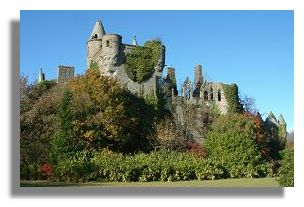 Buchanan (Buchanan Castle - illustrated here - and Buchanan Smithy in Stirling). Buchanan is an ancient Scottish family name, dating back to the eleventh century. Its origin is said to be from 'Both-Chanain' (Gaelic for 'Canon's Seat').
Buchanan (Buchanan Castle - illustrated here - and Buchanan Smithy in Stirling). Buchanan is an ancient Scottish family name, dating back to the eleventh century. Its origin is said to be from 'Both-Chanain' (Gaelic for 'Canon's Seat').
- Chalmers - there is a Chalmers Hope in the Orkney Islands, Chalmers Slack in Moray and Chalmerston in both East Ayrshire and Stirling all based on the Scottish surname of Chalmers, the Chalmers family being a sept of Clan Cameron.
- Daniel McIntyre - the Macintyre clan is believed to be an offshoot of the MacDonalds, McIntyre meaning 'son of the carpenter' in Gaelic. The neighbourhood commemorates Dr Daniel McIntyre, Superintendent of Winnipeg Schools from 1885 to 1928. Dr McIntyre was born in Dalhousie, New Brunswick, possibly in 1852 (Manitoba Historical Society); he was a contemporary of Winnipeg School Board Architect J.B. Mitchell (see entry on JB Mitchell below).
- Dugald - a Scottish personal name and originally a surname in its own right but is now usually seen as MacDougall. A descendant of Somerled, King of the Isles, was the first to use the name. The Gaelic 'dubh-gall' meaning 'dark stranger' may have been applied to the invading Danes in the outer isles (Rampant Scotland site on Scottish forenames). No information has been found on the origin of the name of the Winnipeg neighbourhood, which is situated on Dugald Road, Transcona, i.e. the main road to the town of Dugald some 20 kilometres to the east of Winnipeg.
- Fort Whyte - the surname Whyte is both Scottish and English, from the Old English 'hwit' mean 'white'. The Scottish Whytes are septs of both Clan Lamont and Clan MacGregor. The name of this neighbourhood has a definite connection with Scotland since it refers to Scots-born railwayman William Whyte (1843-1914). George Siamandas's website states that Fort Whyte received its name because of a 'battle' over railway rights in 1888 between 300 Winnipeggers supported by provincial Police and a group of CPR employees led by Whyte, who had recently been promoted to the post of General Superintendent of the Western Division of the CPR. For further information, see the entries below for Whyte Ridge and William Whyte.
- Fraser's Grove - there is a Fraserburgh in Aberdeenshire and a Fraserford in Dumfries & Galloway, both based on the Scottish surname of Fraser. This small neighbourhood in the Kildonan area takes its name from the street, the name of which honours William Fraser, a Winnipeg farmer and politician (Wikipedia article on William Fraser, retrieved in June 2008).
- Glendale (Highland). The name simply means 'valley'. The unusual feature of this name is that it is a tautology - 'valley' features twice, first in Gaelic (gleann) then in Norse (dalr). Glendale is one of the most commonly used names for suburbs and neighbourhoods in North American cities.
- Glenelm - although there are no towns or villages in Scotland called Glenelm, there are streets with this name (e.g. Glenelm Place, a residential street in Bellshill, North Lanarkshire) as well as buildings. Winnipeg's Glenelm is possibly a borrowing from Regina, or vice-versa.
- Glengarry Park - there are places in Aberdeenshire and Highland called Glengarry. Nearly all the streets in this East St. Paul neighbourhood have Scottish names: Applecross Drive, Armytage Place, Clanranald Place, Claymore Place, Clydesdale Drive and Place, Cromarty Place, Dr Hugh McDonald Drive, Gairloch Place, Glenmoor Drive, Gordon Edward Crescent, Invergarry Place, Lochiel Place, Orkney Drive and Place, Skye Place, Strathmore Place and Tweedsdale Crescent. Two other streets - Kiltartan Drive and Kiltartan Place - sound Scottish enough but the name is actually Irish.
- Glenwood (Aberdeenshire).
- Gordon
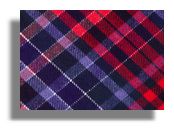 (Scottish Borders as well as many other places throughout Scotland with Gordon as part of the name, e.g. Gordonstoun, Gordonstown and Gordonsburgh). Gordon is also the name of a place on the Isle of Man, probably having been taken there by Scottish settlers. The Gordon tartan most frequently seen is the regimental tartan of the Gordon Highlanders, shown here. This community, on the north-west perimeter of Winnipeg, was probably named for livestock dealer and politician James T. Gordon (1858-1919).
(Scottish Borders as well as many other places throughout Scotland with Gordon as part of the name, e.g. Gordonstoun, Gordonstown and Gordonsburgh). Gordon is also the name of a place on the Isle of Man, probably having been taken there by Scottish settlers. The Gordon tartan most frequently seen is the regimental tartan of the Gordon Highlanders, shown here. This community, on the north-west perimeter of Winnipeg, was probably named for livestock dealer and politician James T. Gordon (1858-1919).
- Grant Park - there is a place called Grant in Perth & Kinross. There are also many other places in Scotland with this Scottish family name as part of the name, for example Grantlodge, Grantshouse and Grantown-on-Spey. Places beginning with Grant can also be found in England but in the majority of these instances 'Grant' has a different meaning. This neighbourhood was "probably named for Cuthbert James Grant (1796-1854)." (Manitoba Historical Society). The son of a Scottish father and a métis (half-Native American) mother, Grant was a prominent métis leader. Educated in Scotland, he joined the North West Company (Wikipedia article on CJ Grant, retrieved in June 2008).
- Grassie - there is a Grassiehill and Grassieslack in Aberdeenshire. The Winnipeg neighbourhood takes its name from Grassie Boulevard. According to the Manitoba Historical Society website, this boulevard was named for William Grassie, who was born in Dumfriesshire, Scotland on 27 July 1872. A real-estate agent, Grassie had served as President of the St. Andrew's Society and was a Past Chief of Clan Stewart.
- Hyland - this small East St. Paul neighbourhood could well recall the Highlands of Scotland, given the names of its streets: Glenlivet Way, Highland Park Drive and Tartan Way.
- Inkster Faraday, Inkster Gardens, Inkster Industrial Park and North Inkster Industrial - Inkster is a place in the Orkney Islands. These neighbourhoods are all located along Inkster Boulevard. The name honours either John Inkster (1799-1874), a stonemason in the service of the Hudson's Bay Company, or his son, Colin Inkster (1843-1934), sheriff, member of the first legislature of Manitoba and one of the oldest and best known citizens of Winnipeg. John Inkster was born in Scotland, in the Orkney Islands (Manitoba Historical Society).

- Kil-Cona Park - although no such place actually exists in Scotland, the name of this neighbourhood can be claimed for Scotland as it seems to represent a blend of Kildonan and Transcona (see entries below). The illustration here is of Lord Strathcona.
- Kildonan Crossing, Kildonan Drive, Kildonan Meadows, Kildonan Park, East Kildonan, North Kildonan, Old Kildonan, West Kildonan and West Kildonan Industrial - Kildonan is the name of several villages in Scotland, in Argyll & Bute, Dumfries & Galloway, Highland, North Ayrshire and South Ayrshire. These Winnipeg communities and neighbourhoods take their name from the original Parish of Kildonan, which formed part of Lord Selkirk's Red River Settlement (see Lord Selkirk below). It is probable that Kildonan was named for the village or glen in Sutherlandshire in the far north of Scotland - an area severely affected by the Highland Clearances.
- Kirkfield Park - there are places called Kirkfield in Highland; also Kirkfieldbank in South Lanarkshire. Kirkfield is also the name of a place in Northumberland, England. The Winnipeg neighbourhood was named for Kirkfield, Ontario, a town associated with the entrepreneur Sir William Mackenzie (1849-1923), a railway contractor for the Canadian Northern Railway. Sir William was born near Peterborough, Ontario and became a teacher and politician before entering business as the owner of a sawmill and gristmill in Kirkfield, Ontario (Manitoba Historical Society and Wikipedia article on William Mackenzie, retrieved in June 2008). His son, Roderick J. Mackenzie, developed the area now known as Kirkfield Park. The Wikipedia article on Kirkfield, Ontario - citing Rayburn, Alan. Place Names in Ontario. University of Toronto Press. p. 183 - provides the following explanation of the Scottish origin of the name: "Kirkfield is a village located in the city of Kawartha Lakes, in the Canadian province of Ontario. The unincorporated village was named in 1864 after the initial name, Novar, was rejected by the government. A list of 8 possible choices was then offered. The village, being predominantly Scottish at the time, chose Kirkfield, after Kirk' o' Field in Edinburgh." (article retrieved from Wikipedia in November 2011).
- Kirkness (Orkney Islands and Shetland Islands, both spelt Kirk Ness).
- Leila-McPhillips Triangle - this neighbourhood takes its name from two intersecting thoroughfares - Leila Avenue and McPhillips Street. The McPhillips part of the name is likely to be Scottish. Black (1996), the authority on Scottish family names, gives the name as MacPhilip - 'son of Philip'. McPhillips Street commemorates George McPhillips (c1848-1913), a land surveyor. Leila Avenue, on the other hand, was named for Leila Neil, neighbour to developer Robert N. Lowery (Manitoba Historical Society). Neil is both a Scottish and an Irish name, meaning "champion" in Gaelic; the name originally came from "Niall of the Nine Hostages", a 4th century king of Tara in Ireland.
- Logan CPR - there is a Logan in Dumfries & Galloway as well as in East Ayrshire (the latter being the likely origin of the family name Logan). According to the Manitoba Historical Society website, this neighbourhood, which takes its name from Logan Avenue, honours either Robert Logan (1773-1866), or Winnipeg mayor Alexander Logan (1841-1894) - see also West Alexander below.
- Lord Selkirk and Lord Selkirk Park - these neighbourhoods no doubt commemorate Thomas Douglas (1771-1820), the 5th Earl of Selkirk, who was responsible for bringing the first party of Scottish settlers to Manitoba in 1811. A Scottish philanthropist who was concerned about the plight of crofters being cleared from the Highlands by their landlords, Lord Selkirk acquired a land grant called Assiniboia to serve as an agricultural colony for the Hudson's Bay Company (of which he was a major shareholder). Point Douglas and the town of Selkirk are other Winnipeg localities whose names honour Lord Selkirk.
- Mathers - there is a Mathershead in the Shetland Islands as well as a Mathersgrave in Derbyshire, England. This neighbourhood takes its name from Mathers Avenue. The avenue, in turn, was named for Judge Thomas Graham Mathers (1859-1927). Judge Mathers was born at Lucknow, Ontario, son of Christopher Mathers formerly of County Armagh, Ireland, and Rachel Graham of County Fermanagh, Ireland (Manitoba Historical Society). The connection is thus Irish in the first instance, but the name is probably Ulster Scots rather than native Irish since Black (1996) lists Mather as a form of Maider, which he says is common in the Laurencekirk area (Aberdeenshire) and may be from the place name Mathers.
- Maybank (Midlothian).
- McDonald - MacDonald is one of the best-known Scottish surnames, though there are Irish McDonalds as well. There are numerous branches of the MacDonald clan such as MacDonald of Sleat, MacDonald of Clanranald, MacDonnell of Glengarry and MacDonnell of Keppoch. No information has been found on the identity of the individual whose name was given to this St. Andrews neighbourhood. It is possible that the name could be associated in some way with that of the neighbourhood's main road, Donald Road.
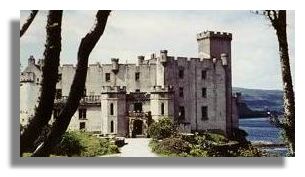
- McLeod Industrial - McLeod is an ancient Scottish clan of Norse origin whose ancestral seat is Dunvegan Castle on the Isle of Skye - illustrated here. The neighbourhood was named for Donald McLeod, a pioneer whose original cabin was situated at the intersection of McLeod Avenue and Henderson Highway (Manitoba Historical Society).
- McMillan - Macmillan is a Scottish clan whose origins go back to the 12th Century. The name is derived from the Gaelic MacMhaolain - 'son of the bald or tonsured one' - suggesting an ecclesiastical origin. The Winnipeg neighbourhood takes its name from McMillan Avenue, which commemorates Ontario-born Daniel Hunter McMillan (1846-1933), Lieutenant-Governor of Manitoba (Manitoba Historical Society).
- Melrose (Scottish Borders). Melrose has proven to be a popular name for neighbourhoods in many cities around the world, possibly because of its association with Sir Walter Scott whose residence, Abbotsford, is in the area. According to the Penguin Dictionary of British Place Names (Room, 2003), the name means 'bare heath' in Brythonic Celtic - 'mel' being cognate with Modern Welsh 'moel' (bald or bare) and 'rose' with Modern Welsh 'rhos' (heath or moor).
- Minto (Scottish Borders). This name, like Melrose (see above) is also based on an old Brythonic Celtic word, cognate with Modern Welsh 'mynydd' (mountain) but with the addition of the Saxon/Old English element 'hoh' (hill spur) which was probably added after the Celtic word had lost its meaning locally. (Brythonic Celtic died out in southern Scotland around 1100, being replaced by the Gaelic form of Celtic in the west and Old English/Auld Scots in the east.). The neighbourhood was named for Gilbert John Elliott Murray, 4th Earl of Minto (1845-1914) who served as Governor General of Canada (Manitoba Historical Society).
- Munroe, Munroe East and Munroe West - Munroe is a variant of Munro, a Scottish family name. These neighbourhoods take their name from Munroe Avenue, which had been named for George F. Munroe, long-time lawyer and secretary for the former municipality of Kildonan (Manitoba Historical Society).
- Murray Industrial Park - there are several places in Scotland based on the ancient Scottish family name of Murray. Examples include Murray's Hill (Perth & Kinross), Murrayfield (Edinburgh) and Murraythwaite (Dumfries & Galloway) and many others. The name has also travelled to England, e.g. Murray's Rock in Devon. In a communication received from Charlene Vickers, a resident of Winnipeg, it was stated that the neighbourhood takes its name from Munroe Avenue, which was named for Donald Murray, one of the 1815 settlers, who was perhaps born in Scotland.
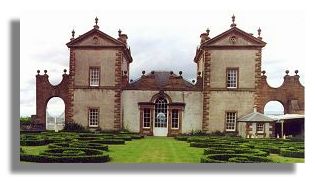
- North Point Douglas and South Point Douglas - there is a Douglas in South Lanarkshire (the original territorial base of the powerful Douglas family) as well as in Ireland and on the Isle of Man. A number of Douglas titles later devolved to the Duke of Hamilton and the eldest son of the Duke is now given the title of Marquess of Douglas. The illustration here is of Chatelherault, the hunting lodge of the Hamiltons. The Winnipeg neighbourhoods were named for Thomas Douglas, 5th Earl of Selkirk (1771-1820) who brought Scottish settlers to the Red River area in 1812 (Manitoba Historical Society) - see Lord Selkirk above.
- Portage-Ellice - This Winnipeg neighbourhood takes its name from Ellice and Portage Avenues. Ellice Avenue was named for the Hudson's Bay Company trading post Fort Ellice in southwestern Manitoba which, in turn, was named for HBC investor Edward Ellice (1783-1863), merchant and politician (Manitoba Historical Society). Edward Ellice was born in London, England, to a Scottish merchant family that was active in the Quebec trade (Manitoba Historical Society). Portage, on the other hand, is a French name.
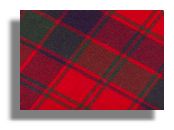
- Robertson - there is a Robertson Park in Renfrewshire based on this Scottish surname. The Robertson tartan is shown here. The neighbourhood was named for clergyman James Roberston (1838-1930), who was born in Dull, Perth & Kinross, Scotland, his family moving to Canada in 1855 (Manitoba Historical Society).
- Roslyn - a variant spelling of Roslin, a village south of Edinburgh in Midlothian, and home to Rosslyn Chapel, the elaborately carved chapel which features in the Da Vinci Code best-seller. Its etymology is obscure, some sources stating that the name comes from the Gaelic (Q-Celtic) for 'headland of the waterfall' while others prefer a Brythonic (P-Celtic) origin meaning 'moor of the holly' from words cognate with Modern Welsh 'rhos' and 'celyn'. The reason for the name of the small Winnipeg neighbourhood is equally uncertain (Manitoba Historical Society). Roslin and its variants Roslyn and Rosslyn became popular names for towns, neighbourhoods and streets throughout the English-speaking world, possibly because of their mention in two of Sir Walter Scott's works: the Lay of the Last Minstrel and Rokeby. As pointed out by Ayto and Crofton (2005), during the 18th and 19th centuries Roslin Castle, Chapel and Glen "proved a magnet for those in search of the picturesque" (p. 934) and were visited by notable Scottish and English artists, poets and authors including Alexander Nasmyth, Samuel Johnson, James Boswell, Robert Burns, Sir Walter Scott and William Wordsworth.
- Rossmere - there are places called Ross in the Scottish Borders, Dumfries & Galloway, Highland and Perth & Kinross. There are also many other places in Scotland that have Ross as part of the name. (The same is true for England and Ireland, though less commonly so than for Scotland.) Ross is of course a fairly common Scottish family name originating nearly 900 years ago from two very different sources: Yorkshire in northern England (the Ayrshire Ross's) and that part of the Highlands of Scotland once known as Ross-shire. According to the Manitoba Historical Society website, the neighbourhood was named after 'Rossmere', the residence of early pioneers Malcolm and Roderick Ross.
- Selkirk, East Selkirk and East Selkirk Station - Selkirk is a town in the Scottish Borders. The names of these communities to the northeast of Winnipeg commemorate Lord Selkirk (see above) rather than the Scottish town itself.
- Southdale (Shetland Islands). However, since this neighbourhood is located to the south of the city centre, this may be a purely descriptive name.
- Spence - Black (1996) states that this Scottish family name is derived from the office of custodian of the larder or provision room - 'despense' in Old French. The neighbourhood was named for James Spence (1815-1900), who was born in Scotland and who came to the Red River Colony in 1841 (Manitoba Historical Society).
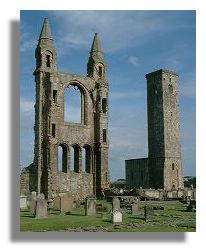
- St Andrews (Fife - and the patron saint of Scotland). The ruins of St. Andrews cathedral are shown here. The community of St. Andrews to the immediate NE of Winnipeg may well have taken its name from that of the local Anglican church, in which event the connection with Scotland would be very indirect.
- Symington Yards - there are places called Symington in South Ayrshire, South Lanarkshire and the Scottish Borders. The industrial neighbourhood in which the Canadian National Railway yards are situated was named for Herbert James Symington, lawyer (Manitoba Historical Society).
- Templeton-Sinclair - the neighbourhood takes its name from intersecting streets in West Kildonan (Templeton Avenue and Sinclair Street). Both are Scottish family names, though Templeton could also be English. Sinclair derives from St. Clare in Normandy, France, the earliest record of which in Scotland occurs in the barony of Roslin in 1280 (Scarlett, 1975). Sinclair Street honours Duncan Sinclair, an early land surveyor (Manitoba Historical Society). The surname Templeton is found mainly in Ayrshire and Lanarkshire and probably derived from Templeton near Dundonald, Ayrshire (Black, 1996), though places with this name can also be found in Aberdeenshire and Angus. Templeton Avenue was named for pioneer William Templeton (ancestry not recorded), who owned the land on which the Kildonan Golf Course is situated today (Manitoba Historical Society).
- Transcona, Transcona Industrial Park, North Transcona, North Transcona Industrial Park and South Transcona - the names of these neighbourhoods all honour Lord Strathcona (Donald Alexander Smith, born in Forres, Scotland, in 1820), a pioneer of the Hudson's Bay Company and the Canadian Pacific Railway. Transcona was a city in its own right until its amalgamation with the City of Winnipeg in 1972, the name being made up from a combination of National TRANScontinental Railway and Lord StrathCONA.
- Turnbull Drive - Turnbull is a Scottish and English family name from the border region. Black (1996) suggests that the name came from Old English 'Trumbald' meaning 'strongly bold'. The neighbourhood was named for Thomas Turnbull, a maintenance engineer with the Canadian National Railway at Winnipeg (Manitoba Historical Society).

- Waverley Heights and Waverley West - Waverley is the name of the main railway station in Edinburgh (pictured here). The station received its name in the 1850s, from the title of a series of novels by Sir Walter Scott (a monument to whom had been erected near the future railway station in 1844). Sir Walter, in turn, had borrowed the name from Waverley Abbey, a ruined Cistercian monastery in Surrey, England. These Winnipeg neighbourhoods, located along Waverley Street in the Fort Garry area, were indeed named for the Waverley novels by Scottish author Sir Walter Scott (1771-1832) (Manitoba Historical Society).
- West Alexander - This neighbourhood is located at the (old) west end of Alexander Avenue. The avenue, in turn, had been named for Winnipeg mayor Alexander Logan (1841-1894). Alexander Logan's father, Robert Logan, a fur trader with the Hudson's Bay Company, is believed to have been born in Scotland (Manitoba Historical Society) - see also Logan CPR above.
- Whyte Ridge and William Whyte - These neighbourhoods were named for a Scotsman, railwayman William Whyte (1843-1914). The son of a coal merchant, William Whyte was born in Charlestown, Fife. He came to Canada in 1863, as a brakeman on the Grand Trunk Railroad. By 1910, he had become Vice-President of the Canadian Pacific Railway (CPR) and was knighted in 1911 (Dictionary of Canadian Biography). See also Fort Whyte above.
- Woodhaven (Fife).
Some of the following localities may also prove on further investigation to have a link with Scotland. However, these names are also associated with other parts of the British Isles:
- Booth - there is a Booth in the Orkney Islands, Booth of Toft and Booths in the Shetland Islands, and a water feature called Booths Burn in Dumfries & Galloway. However, Booth occurs even more widely in English place names and is also considered to be an English family name from Yorkshire.
- Brooklands (Dumfries & Galloway) though far more popularly used throughout England and is also found in south Wales.
- Fairfield Park (Fairfield in Clackmannanshire, Shetland Islands and Stirling). Fairfield is even more commonly found throughout England and is also found in Ireland.
- Fort Garry, Fort Garry Industrial Park and West Fort Garry Industrial - the River Garry in the Scottish Highlands gives its name to the valley through which its flows (Glen Garry), a lake (Loch Garry) and the village at its confluence with Loch Oich (Invergarry). The Winnipeg neighbourhoods were named, however, after the Hudson's Bay Company trading post established in 1822 at the confluence of the Assiniboia and Red Rivers. Nicholas Garry was the deputy governor of the Hudson's Bay Company (Wikipedia article on Fort Garry, retrieved in June 2008). Nicholas Garry (c1782-1856) was born in England, probably the illegitimate son of a wealthy London merchant who financed his upbringing (Manitoba Historical Society). It is not known whether the Garry family had Scottish ancestry. As a family name, Garry is equally likely to be English or Irish.
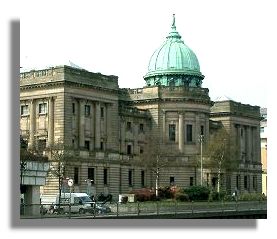
- JB Mitchell - there is a Mitchell Hall in East Lothian, a Mitchell Hill in Dumfries & Galloway and the Scottish Borders, Mitchellhill in Aberdeenshire and Mitchellslacks in Dumfries & Galloway, but place names based on Mitchell are even more numerous throughout England, including Mitchell itself in Cornwall. The name Mitchell is found frequently enough in Scotland, however, for there to be a family tartan. The illustration here shows the Mitchell Library in Glasgow - the largest public lending library in Europe. The name of this Winnipeg neighbourhood commemorates Colonel James Bertram Mitchell (1852-1945), an architect who was born in Gananoque, Ontario (Manitoba Historical Society). Mitchell was elected to the Winnipeg City School Board in 1888 and four years later he was appointed Architect and Commissioner of School Buildings and Supplies. Together with his contemporary, School Superintendent Daniel McIntyre (see above), Mitchell designed and supervised the building of approximately 48 new schools. See www.wsd1.org/jbmitchell.
- Kingston Crescent - there is a Kingston in Angus, City of Glasgow, East Lothian, Moray and Renfrewshire. Kingston is also a popular place name in southern England and is found in Ireland and Wales as well.
- Norwood, Norwood East, Norwood Flats and Norwood West - there is a village in Dumfries & Galloway called Norwood, but these neighbourhoods are far more likely to have been named for the suburb in south London or other places in England.
- Oakwood Estates - there is an Oakwood in Scottish Borders, Moray and Perth & Kinross) also six places in England.
- Springfield, Springfield North and Springfield South - there are towns and villages called Springfield in Argyll & Bute, Dumfries & Galloway, Fife, Highland and Perth & Kinross. However, Springfield is also commonly found in England and Wales as well as in many other North American cities.

- Wellington Crescent - there is a Wellington in Aberdeenshire and a Wellington House in Midlothian, but Wellington is found more commonly in England than in Scotland. On the surface, it would seem highly probable that this Winnipeg neighbourhood, like so many neighbourhoods in other cities, commemorates Arthur Wellesley, the first Duke of Wellington, hero of the Battle of Waterloo. His statue in Glasgow is usually irreverently "crowned" with a traffic cone! This is a rare instance, however, of Wellington referring to a personal name, rather than the famous duke (who no doubt popularised its use in the 19th century). The crescent, and thus the neighbourhood, was named for businessman Arthur Wellington Ross (1846-1901), lawyer, businessman and politician, who was born at Nairn, Ontario, son of Donald Ross (Manitoba Historical Society). It seems very likely, therefore, that this neighbourhood has a Scottish connection, albeit indirect.
- Weston and Weston Shops - there are places in Highland, Moray and South Lanarkshire called Weston; also Weston Burn in the Scottish Borders but Weston is far more popularly used all over England and is occasionally found in Wales as well.
- Westwood (Dumfries & Galloway, Highland, Perth & Kinross, Stirling and South Lanarkshire). Westwood is also commonly found throughout England and is a favourite name for neighbourhoods in other Canadian and American cities. Since Westwood is located in the western part of Winnipeg, a purely descriptive origin of the name is suggested.
A final category of neighbourhood and suburban names comprises places that can be found in Scotland but which, in Winnipeg's case, definitely or most probably have no Scottish connection.
- Brockville - Brock features in many place names in Scotland, some examples being Brock Burn in East Renfrewshire, Brock Hill in Dumfries & Galloway and Brockholes in Aberdeenshire. Brock occurs even more commonly in English place names. The origin of the name of this neighbourhood is neither immediately Scottish nor English, however, as it commemorates General Isaac Brock, who fought in the 1812 battle of Queenston Heights, near Niagara Falls, Ontario (Manitoba Historical Society). Sir Isaac Brock (1769-1812) was born on Guernsey in the Channel Islands.
- Earl Grey and Talbot-Grey - These neighbourhoods honour an Englishman, Albert Henry George Grey (1851-1917), Governor-General of Canada from 1904 to 1911. Talbot (from Talbot Avenue), on the other hand, was named for Miss Alice Talbot, first principal of Talbot School, 1891 (Manitoba Historical Society). Talbot is not a Scottish family name.
- Riverside (Stirling) also in England and Wales. The name of this West St. Paul neighbourhood is probably purely descriptive of its location on the banks of the Red River.
- St John's and St John's Park - there is a St John's in the Scottish Borders, but the name is used more commonly in England and is also found on the Isle of Man. These neighbourhoods take their name from the Anglican cathedral in the area, which was named in 1853 by Bishop David Anderson (1814-1885) (Manitoba Historical Society).
- West End (City of Edinburgh and South Lanarkshire) but evenly more commonly found in England and to a lesser extent in Wales. The Winnipeg community of West End is purely a descriptive term for those neighbourhoods located west of Balmoral Street in the downtown area and east of St. James Street and is therefore unlikely to refer to any particular place in Scotland.
Other evidence of the Scottish influence on the development of Manitoba's capital city can be found in the names of streets and roads throughout the metropolitan area. Major thoroughfares include: Balmoral Street, Colville Road (East Selkirk), Donald Street, Dugald Road, Grant Avenue, Henderson Highway, Inkster Boulevard, Logan Avenue, McGillivray Boulevard, McIvor Avenue, McLeod Avenue, McMillan Avenue, McPhillips Street, Nairn Avenue, Ness Avenue, St Andrews Road (St Andrews), Strathnaver Avenue (Selkirk), Watt Street and Waverley Street. Many minor roads and streets also bear Scottish names.
Parks, reserves and sports grounds with Scottish-sounding names include:
- NW area: Albany Park (Bruce Park), Alexander Ross Park (Buchanan), Bonnycastle Park (Downtown), Frank Whyte Park (Mynarski), Isbister Park (Buchanan), Highlander Sportsplex (King Edward), Kinver Park (Tyndall Park), McPhillips Athletic Grounds (Weston), Minto Athletic Grounds (Minto), Murray Park (Saskatchewan North), Robertson Playground (Robertson), Sinclair Park (Inkster Faraday)
- SW area: Bairdmore Park (Richmond West), Berwick Athletic Field (Lord Roberts), Fraser Meadow Park (Ridgewood South), Grant Park Athletic Grounds (Grant Park), Kirkbridge Park (Richmond West), Leon Bell Park (Whyte Ridge), McKittrick Park (Lord Roberts), Montrose Park (River Heights), Wilkes/Waverley Park (Linden Woods)
- SE area: John Forsyth Park (River Park South), Lomond Park (Windsor Park)
- NE area: Anderson Park (Rossmere), Armstrong Park (East Elmwood), Braeside Park (Braeside), Chalmers Park (Chalmers), East Kildonan Centennial Park (Rossmere), Fraser's Grove Park (Kildonan Drive), Kildonan Meadows Park (Kildonan Meadows), Kildonan Yacht Club (River East), Melrose Park (Rossmere), Rossmere Golf & Country Club (Rossmere)
- Rural Municipality of East St. Paul: Clydesdale Park, Glengarry Community Park, Hyland Provincial Wayside Park
Judging purely by the names of its communities, neighbourhoods, highways, parks and reserves, Winnipeg is one of the Canadian cities (along with Calgary, Edmonton, Halifax, Hamilton and Regina) where Scottish influences appear to have been particularly marked. Indeed, Winnipeg would seem to be the most 'Scottish' of all the Canadian cities, a legacy, perhaps, of Lord Selkirk's Red River Colony scheme and the large number of Scotsmen later employed by the railway companies. As with other cities in the western half of Canada, Scottish influences were often indirect since several pioneers whose ancestry was probably Scottish came from the eastern provinces of Canada. Nevertheless, Winnipeg's place names certainly illustrate the far-reaching effects of the Scottish diaspora of the 18th, 19th and early 20th centuries.
Acknowledgments:
- Ayto, John & Crofton, Ian (Compilers) (2005). Brewer's Britain & Ireland: The History, Culture, Folklore and Etymology of 7,500 Places in These Islands. (Weidenfeld & Nicolson, London).
- Black, George F. (1996). The Surnames of Scotland (Birlinn Ltd, Edinburgh).
- City of Winnipeg Neighbourhood Profiles for a recent listing of community areas and neighbourhoods.
- Dictionary of Canadian Biography.
- History in Winnipeg Street Names, Manitoba Historical Society website
- Room, Adrian (2003). The Penguin Dictionary of British Place Names. (Penguin Books, London).
- Scarlett, James D. (1975). The Tartans of the Scottish Clans. (Collins, Glasgow and London).
- Siamandas, George: The Bloodless Battle of Fort Whyte
- Wikipedia: List of Winnipeg Neighbourhoods.
- Winnipeg Street Map, 2005 (MapArt Publishing, Oshawa).
- Charlene Vickers, Winnipeg, who provided information on the origin of the names of several neighbourhoods.
- Douglas Allen, Site Manager, Splash Dash Water Bus Services, Winnipeg, for information on Armstrong's Point.
- Websites, place name gazetteers and published Ordnance Survey maps of British and Irish cities, towns, villages and counties.
© Ian Kendall
If you wish to contact Ian about his research, his e-mail address is ian.kendall1@bigpond.com.
Melbourne, Australia, November 2004
Revised November 2011



